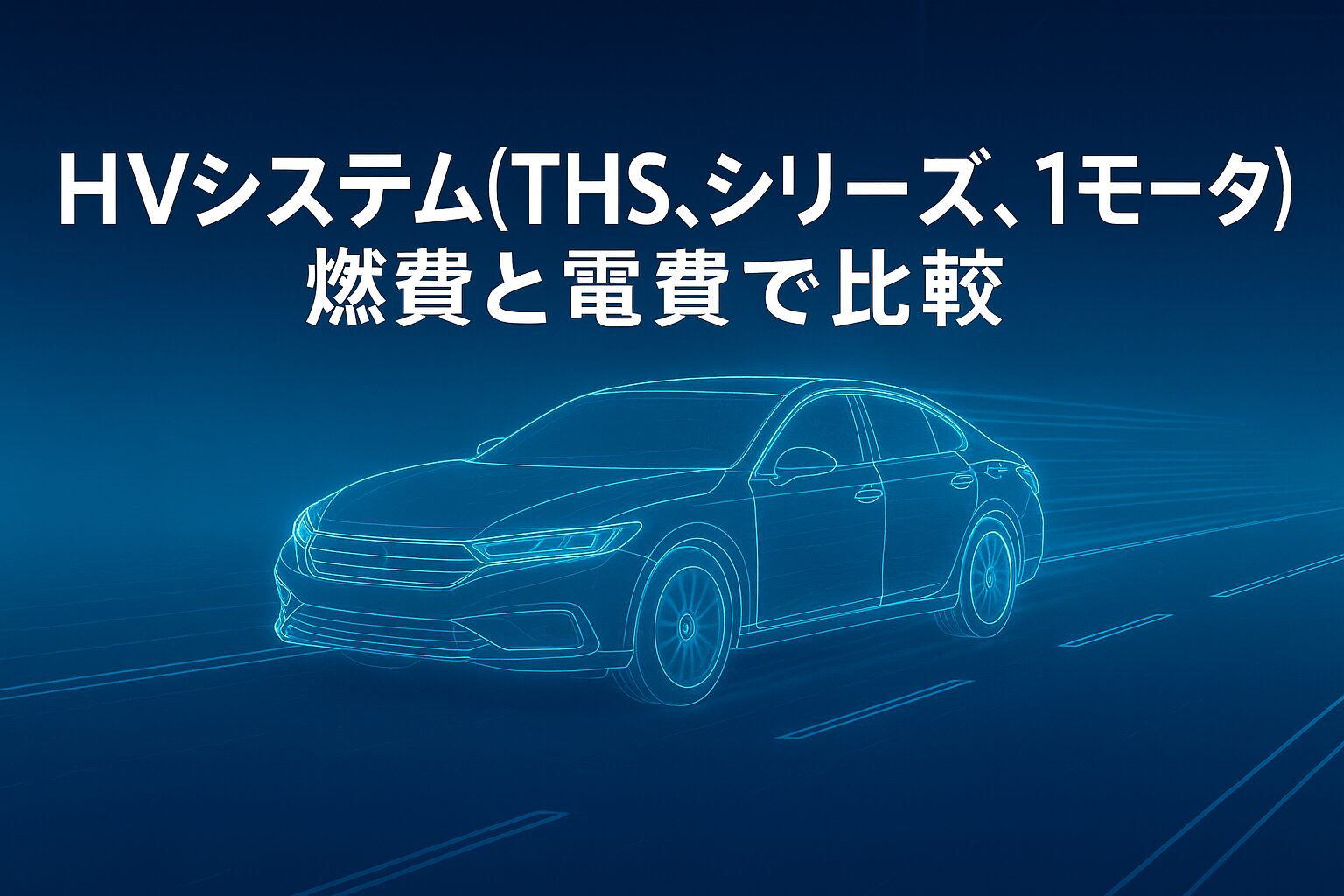初めに
これまでは電気自動車(EV)を題材として解説をしてきましたが、今日からはハイブリッド(HV)システムの解説を行います。(筆者はHVシステムの開発歴が長かったので、こちらの方が得意です。)
HVシステム編の初回ということで、今回は2モータHV,1モータHVなどのざっくりとした特徴・性能比較を行おうと思います。
システム構成解説
EVのシステムはMGからギヤを介してタイヤに繋がるシンプルな構造が多いですが、HVシステムには多様なシステム構成が存在します。今回は代表な構成である2モータHV(THS、シリーズ、シリパラ)、1モータHVについて解説しようと思います。
〇THS(スプリット)
THSはTOYOTAで有名なHVシステムですね。モータ2つとプラネタリギヤ(遊星歯車)による構造が特徴で、エンジンを常に効率の良いポイントで動作させる電気CVT走行が可能です。燃費に関しては電気CVT効果で最高クラスの性能ですが、電費に関しては常にプラネタリやMotor1が連れ回る関係でやや弱みが有ります。

〇シリーズ
日産Note(e-Power)などに採用されているシリーズシステム。Motor1は完全にエンジンによる発電用で、Motor2で駆動をするのが特徴です。燃費に関してはエンジンのトルクを直接駆動力に用いるモードが作れないので燃費はやや落ちますが、電費に関しては無駄な部品が連れ回らないシンプルなEV走行ができるので電費に関しては最高クラスです。

〇シリーズパラレル
ホンダのHVシステム(e:HEV)などに採用されているシリーズパラレルシステム。シリーズシステムにクラッチを追加した構造です。Motor1とMotor2の間を繋げたり、解放したりすることができます。シリーズシステムに対してエンジンのトルクを直接駆動力に用いるモードを作ることが可能になり、燃費が向上しています。電費はシリーズシステムとほぼ変わりません。

〇1モータHVシステム
1モータHVシステムの中でも多様なシステム構成がありますが、今回は代表的な下図のシステムを解説します。通常のガソリン車の構成をベースにクラッチとモータをエンジン-トランスミッション間に配置しています。クラッチはエンジンを切り離してEV・回生走行時の効率を高めるために採用されていますが、簡易なハイブリッドシステム(48V等)にはエンジン切り離しクラッチが無いものも多いです。
TOYOTAのクラウンクロスオーバーにはTHSと1モータHVの車種があり、1モータHVは本システム構成になっています。
2モータHVと違って変速があるので、従来のガソリン車に近い走行フィーリングが可能なところが利点。一方で、2モータHVと比較すると燃費・電費ともに劣ります。

〇リンク
・シリーズパラレル各モード紹介
比較
前章で説明した各システムを燃費、電費性能で比較した図を以下に示します。(筆者の感覚によるものです。)
・燃費と電費を比較、10点を最高として10段階評価。

終わりに
今回はHVシステムの各構成の説明と、燃費・電費目線での比較を行いました。今回、なぜこのようなシステム性能になるかについては、かなりボカシて説明したので、次回以降で各システムに対してしっかりと解説していきたいと思います!
Summary in English:
Hybrid vehicles (HVs) have a variety of system configurations compared to electric vehicles (EVs), resulting in significant differences in fuel economy and power consumption. Typical configurations include two-motor HVs (THS, series, and series-parallel) and single-motor HVs, each with its own unique characteristics.
The THS system, adopted by Toyota, enables electric CVT driving using two motors and a planetary gearbox. It offers very high fuel economy but slightly lower power consumption. Series systems, such as those found in Nissan e-POWER, use the engine exclusively for power generation while the motor provides drive, resulting in high power economy but slightly lower fuel economy. Series-parallel systems, such as those used in Honda e:HEVs, allow the engine to be directly driven by a clutch, improving fuel economy while maintaining power consumption.
On the other hand, single-motor HVs are based on the configuration of gasoline-powered vehicles, with a motor and clutch placed between the engine and transmission. These systems feature enhanced EV driving and regenerative efficiency, providing a driving feel similar to that of conventional gasoline-powered vehicles, but their fuel economy and power consumption are inferior to two-motor HVs.
If I were to rate the performance of each configuration on a scale of 1 to 10, I would say that the series-parallel type offers good balance and high performance in terms of both fuel economy and electricity consumption, the THS type specializes in fuel economy, the series type specializes in electricity consumption, and the 1-motor HV is considered a simple type.
In the next article and beyond, we will explain in detail why these configurations achieve such performance from the perspective of operating principles and control.



コメント